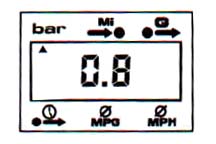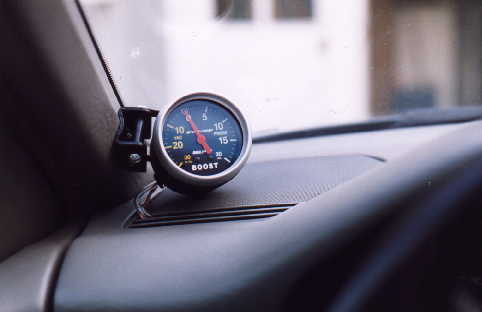

|
Stock Digital Boost Gauge, Aftermarket Boost Gauges, Pressure Conversion Info. The stock digital boost gauge located in the instrument cluster displays the intake manifold "absolute" boost pressure, from ~0.0 bar to 2.0 bar. The 1992 Audi S4 digital boost gauge reads from ~0.0 to 2.5 bar  Courtesy of Audi of America Readings below 1.0 are considered intake manifold "vacuum" readings, values above 1.0 are considered intake manifold "boost" pressures at sea level. The stock digital boost gauge receives a voltage signal from the ECU which ranges from ~0.2 to 5.0 volts. There is a micro-controller inside the instrument cluster which takes this voltage information and converts it to a digital reading on the LCD display in Bar. This micro-controller is also used for the other displays, i.e. average MPG, driving time, miles to empty etc. Unfortunately, the response of this stock boost gauge is very slow and it will not show rapid changes in the intake manifold pressure. It also has limited resolution, being only able to display tenths of a bar, so you don't know if the 1.7 bar display means you have 1.70 bar, or whether you actually have 1.79 bar. With a modified ECU in the 10V Turbos, often times the turbo is producing 1.8 to 2.0 in the intake manifold during the brief overboost period, but the stock digital boost gauge is only reading 1.7 to 1.8 bar because of its slow response. The 1991 200TQ 20V Turbos should make 1.8 bar boost with a stock ECU. The 1992 Audi S4 with overboost mode, should make 2.15 bar with the stock ECU. Keep in mind, that the modified ECU's for the 1991 200TQ 20V Turbo engines often have changed the internal pressure sensor, from the stock 2.0 bar unit, (200kPa), to the higher range 2.5 bar or 3.0 bar unit (250kPa or 300kPa respectively). In this case, the reading on the stock boost gauge will read low, and be incorrect. If you have changed to the 2.5 bar pressure sensor inside the ECU, you will have to multiply the reading on the stock boost gauge by 1.25 to get the actual boost pressure in the manifold. If you have upgraded to the 3.0 bar pressure sensor, you will have to multiply the stock boost gauge reading by 1.5 to get the actual boost in the manifold. The later Audi S4 ECU comes stock with the 2.5 bar pressure sensor, and can be upgraded to the 3.0 bar unit. In this case, if you have the 1992 Audi S4 with the digital boost gauge in the instrument panel, you would multiply the stock boost gauge reading by 1.2 when you upgrade to the 3.0 bar pressure sensor. Most common pressure gauges do not display "absolute pressure" but use atmospheric pressure as a reference level and measure the "difference" between the actual pressure and atmospheric pressure. This difference pressure is called "gauge" pressure. The actual pressure is called the "absolute pressure" as mentioned above and is referenced to a complete vacuum. Gauge pressure is typically given either above or below atmospheric pressure, i.e. above is pressure, below is vacuum. Note: Atmospheric pressure is that pressure that is all around us and often overlooked. Atmospheric pressure decreases at higher altitudes. Gauge Pressure (Pg) = Absolute Pressure (Pabs) minus the Atmospheric Pressure (Pa). Or stated another way, Absolute Pressure = Gauge Pressure + Atmospheric Pressure. Most common pressure gauges that are not "absolute" pressure gauges, will have higher readings as you go up in altitude above sea level. For example, at sea level if your boost gauge reads 18 psi above the atmospheric pressure, (14.7 psi). With the same amount of boost pressure in the intake manifold, this same pressure gauge will read 22.6 psi at 10,000 ft altitude, due to the atmospheric pressure only being 10.1 psi at this higher altitude. A little history: Evangelista Torricelli (1608-1647), invented the mercury Barometer in 1643. The unit of pressure "torr" was named after him. The mercury Barometer is a long glass tube that has been filled with mercury which is then inverted in a dish of mercury. The space above the mercury in the tube is filled with mercury vapor, whose pressure is extremely low at ordinary temperatures and is ignored. A value of 1 atmosphere (1 atm) is equal to the density of mercury times the height of the mercury in the tube minus the height of the mercury in the dish, times standard gravity and assuming a temperature of 0 degrees Celsius. (Standard gravity equals 32.174 feet/seconds squared or 980.665 centimeters/seconds squared) (Density of mercury at 0 degrees Celsius equals 13.59050 grams/cubic centimeters) . Therefore 1 atm = (13.5950 grams/cubic centimeters) X (76.00 centimeters) X (980.665 centimeters/seconds squared)=1,013,242 grams/centimeter-seconds squared=101,324 Newton/meters squared=101,324 Pascals=2,116 lbs/square feet=14.70 lbs/square inch. Here is some pressure unit conversion information. 1 Bar equals 14.5 psi. which equals 750 torr, which equals 750mm Hg, (millimeters of mercury in a Torricelli Barometer which equals 29.5275 inches of mercury, which equals 100,000 Pascals, or 100 kPa, named after the French scientist Blaise Pascal. As mentioned, A pressure equivalent to that exerted by exactly 760mm of mercury at exactly 0 degrees Celsius, under standard gravity is defined to be 1 atmosphere. 1 atmosphere equals 14.70 psi (pounds per square inch), which equals 1.013 Bar, which equals 760 mm of Hg, which equals 29.9212 in Hg, which equals 406.8 inches of water. As you start to do more modifications that raise the boost level on your engine, you may want to install an aftermarket boost gauge that will do a better job of showing the rapid changes in boost, and one that will provide a better reference to changes in boost levels. The Audi 5000TQ and 200TQ don't have any real good locations for mounting an aftermarket boost gauge, but here is one location on the A-pillar interior trim panel which is not too obtrusive. The gauge can be seen while driving without taking your eyes too far off the road.  It only requires a couple of holes drilled into the plastic/metal trim piece. You can route the gauge hose and illumination light wiring down through the speaker grill area. Some people have also mounted small boost gauges in the center main switch panel in the empty switch slots. A few others have used the cigarette lighter hole area. I used the Autometer #3401 Sport Comp 2 5/8 inch diameter series vacuum/boost gauge which displays vacuum from 0-30 in Hg, and boost pressure from 0-20 psi. According to Autometer this gauge gives +/- 2% accuracy which should be kept in mind when viewing the readings. The boost gauge should be used as a reference tool, to allow you to compare boost levels from day to day, and spot any problems with your engine/turbo, and not to accurately measure the boost. I noticed recently, that Autometer also has a 3303 (2 1/16 diameter) and 3403 (2 5/8 inch diameter) model vacuum/boost gauge, that reads 30in vacuum, and 30 psi of boost pressure. They also have the 5401 series which are liquid filled to dampen needle movement under rough conditions. Note, that these gauges give readings that is referenced to atmospheric pressure, so the relative reading will typically increase as you go up in altitude. Some of the Autometer pressure gauges have a vent screw that can be used to compensate the gauge operation at different altitudes. Autometer can be found on the WWW at Autometer and they show some mounting "pods" which may be adaptable to the Audi Interior. An aircraft type pressure gauge which is an "absolute pressure" type typically reads in inches of mercury (in Hg) and would be more accurate. The cost for the aircraft type gauge should be much higher, but some are actually priced rather low or often times they can be found at surplus stores. Fluke makes a PV500 electronic pressure transducer that plugs into a Digital Multimeter, (DMM) to read vacuum and pressures up to 500 psi. The PV500 can be used to measure the boost levels using a DMM or you can graph out the boost profile of your engine using this PV500 and a portable oscilloscope. You can also build your own low cost pressure transducer using the Motorola MPX4250 series of absolute 0-250 kPa (0-2.5 bar) pressure sensors. Along with a 5 Volt DC supply, and a accurate DMM to measure the output of this sensor, you can get some accurate pressure readings. These sensors can also be used to measure the ambient or atmospheric pressure as you go up in altitude, to calculate the Pressure ratio of the turbo you are using at specific boost levels when at higher altitudes. Copyright © SJM Autotechnik™ , all rights reserved Return to Trouble-Shooting Tips page. Return to SJM Autotechnik™ main page. |
| About Us Privacy Policy Terms of Use Links Customer Service Safety Information Home |